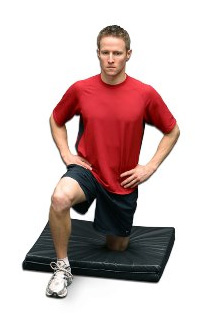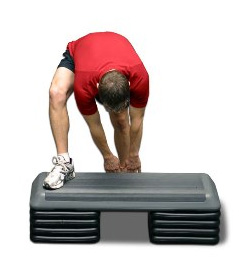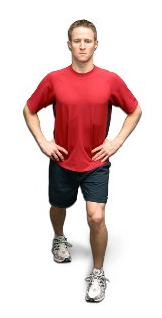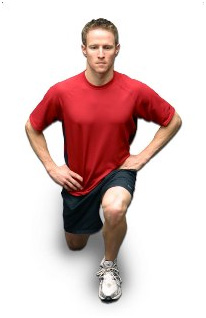Knee discomfort while lunging, walking, and squatting is very common. One of the most common reasons for this discomfort is lack of preparation prior to performing the exercise. The National Academy of Sports Medicine has developed a simple six-step warm-up for lunge preparation. If you have any specific questions, please contact an NASM-certified personal trainer.
Step 1: Perform a self-massage on the thigh region.
Self-Massage
1. Start in a kneeling position with the foam roll oriented horizontally in front of your knees. Now lie across the foam roll so that it is just above your knees and your forearms are on the floor with your elbows bent. Pull your body forward and lateral with your arms, slowly rolling until tenderness is felt. If tender areas are identified, hold for approximately 30 seconds.
2. Hold for 2 to 3 seconds, then release. Repeat 10 times.
Do not allow your low back to arch. Avoid placing weight on your knees.
 Step 2: Perform a self-stretch on the thigh muscles.
Step 2: Perform a self-stretch on the thigh muscles.
Kneeling Stretch with Support
4. Begin with your stretch leg in a kneeling position and the other leg bent at a 90-degree angle. To start the stretch, tighten your gluteus maximus and rotate your pelvis under while maintaining an upright posture.
5. Hold the stretch position for 30 seconds and repeat up to 3 times.

Step 3: Perform a stretch on the upper thigh muscles.
Upper Thigh Stretch
1. Place your stretch leg on top of a sturdy object (table, chair, etc.). Both legs should be pointed straight ahead, as depicted.
2. Slowly allow your upper body to migrate toward the floor until slight tension is felt under your thigh.
3. Adjust the height of the object to suit your individual stretch tolerance. Hold the stretch position for 30 seconds and repeat up to 3 times.
 Step 4: Perform a stretch on the lower body.
Step 4: Perform a stretch on the lower body.
Lower Leg Stretch
1. Place one leg forward, with the rear leg bent approximately 30 degrees.
2. Lean forward while keeping your rear foot flat until slight tension is felt. Do not allow the foot to collapse inward.
3. Hold the stretch position for 30 seconds and repeat up to 3 times.
 Step 5: Slowly practice the lunge.
Step 5: Slowly practice the lunge.
1. To start, stand in a balanced, split-stance posture. This position must be wide enough so the front shin is perpendicular to the floor, allowing the front thigh to achieve a parallel position.
2. Weight should be evenly distributed between your legs, minimizing unnecessary forces on the front leg.
3. An upright posture must be maintained throughout the exercise. Keep your chest up, your shoulders back, your head looking forward, and your knee aligned over the second/third toe.
4. The spine should be positioned in neutral (not flat or excessively arched) prior to movement.
5. Hips should remain level throughout the exercise.
6. The upper body must stay erect during the entire movement.
7. Push through the heel of your front leg.
 Step 6: Stationary split lunge without support
Step 6: Stationary split lunge without support
After performing 20 repetitions, you should be warmed up enough to progress to the stationary split lunge without support.
Perform the lunges slowly and be sure to maintain perfect alignment.